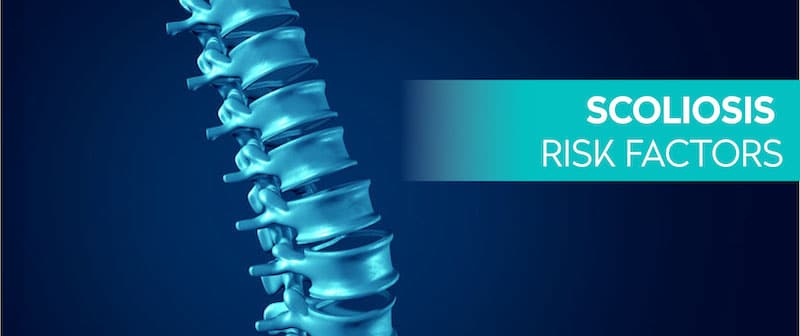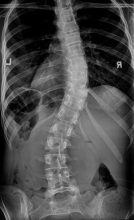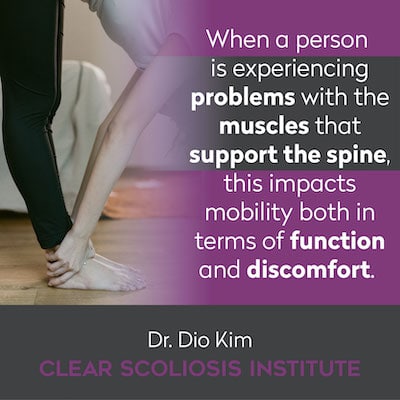
There are many risk factors associated with scoliosis, but they vary widely from patient to patient. Characteristics of the condition that impact the types of risk factors present include the patient’s age, curvature type, curvature size, and the location of the curvature along the spine.
When it comes to the type of risk factors to expect with scoliosis, that answer will differ depending upon the nature of each individual’s condition. The risk factors associated with mild scoliosis can be quite different from those associated with more severe forms of the condition. Let’s start our discussion with risk factors associated with milder forms of scoliosis.
One of the main classification points for scoliosis is whether the condition is mild, moderate, or severe. This designation is determined by just how far out of alignment a patient’s spine is.
When a patient is first diagnosed with scoliosis, this designation is made based on the results of their scoliosis X-ray. The X-ray tells me everything I need to know about the patient’s condition, including their Cobb angle: a measurement in degrees taken from the most tilted vertebra at the apex of the curve.

If a patient has a Cobb angle measurement of 25 degrees or less, this is considered mild scoliosis. Patients with Cobb angle measurements between 25 and 40 degrees are considered moderate scoliosis, and Cobb angle measurements of 40+ degrees are considered as severe scoliosis.
With mild, and even some moderate forms of scoliosis, there aren’t a lot of limitations, noticeable symptoms, or risks of developing additional complications, at least until progression kicks in. The condition’s most common form, adolescent idiopathic scoliosis (AIS), can even be difficult to diagnose because its initial effects can be very subtle.
With mild and moderate forms of scoliosis, patients are most likely to experience subtle postural changes, changes in gait, and in how their clothing hangs on their bodies.
The big risk factors associated with most forms of scoliosis, and especially AIS, are related to progression. Growth is the number one trigger for progression, which is why adolescents are at a higher risk of experiencing rapid progression. Scoliosis progression means the curvature is getting larger.
As a condition progresses, related risk factors increase as the scoliosis moves from mild or moderate into the severe stage.

With severe scoliosis, the aforementioned changes associated with milder forms of the condition are more severe. Postural changes become overt as there’s often an overall asymmetry to the body.
Postural changes and changes to how a person walks are extreme, as are some related risk factors associated with severe scoliosis.
Severe scoliosis can also impact organs, such as the lungs. Rib cage deformities are common at this stage, especially when a patient’s scoliosis is in the thoracic spine (middle back).
When scoliosis causes a rib cage deformity, lung impairment becomes a risk factor. This is because the deformity is pressing on the lungs, affecting lung volume and making it harder to take deep breaths.
This isn’t always noticeable in regular daily activities, but for athletes or long-distance runners, these impairments become more noticeable, and shallow breathing can be a result.
This is why, here at the CLEAR Scoliosis Institute, we like to monitor this complication by measuring a patient’s lung volume before and after treatment.

With severe scoliosis, mobility issues can also develop. Due to uneven pressure on the spine and its joints, motion can be limited as muscles are affected, causing intense pain and trigger points.
When a person is experiencing problems with muscles that support the spine, this impacts mobility both in terms of discomfort and function.
When there is instability in the spinal joints due to an abnormal curvature, the spinal cord is being stretched. As the spine works in tandem with the brain to form the body’s central nervous system, this can affect motor and sensory control.
Neurological disorders are commonly associated with scoliosis, and hormones can also be affected, as they are associated with the brain and central nervous system.
Issues with balance and proprioception are also associated with scoliosis. Proprioception refers to the body’s ability to orient itself in space without visual cues. It can be very difficult for a person with severe scoliosis to close their eyes and stand on one foot.
Balance can also be affected as the body becomes more and more asymmetrical. Often, when someone with severe scoliosis sits down, they end up slouching; this places more pressure on the spinal joints and can cause more pain and misalignment to develop. This affects the overall biomechanics of the spine and those related joints.
Another risk factor that is often overlooked is the emotional strain that a spinal deformity like scoliosis can place on people, especially adolescents and teenagers.
Teenagers don’t want to look or walk differently from their peers, and when they start to feel different and they stand out, this can lead to intense emotional stress and anxiety.
When these young people are faced with a condition that has progressed rapidly or is progressing rapidly, they can lose hope and become depressed. Depression can affect their ability to concentrate on their school work and cause them to fall behind.
You can see how the emotional strain of a condition like scoliosis can affect multiple areas of a young person’s life.
Severe scoliosis is also associated with digestive issues such as constipation, stomach pains, and irritable bowel syndrome.
This can lead to nutritional deficiencies, as the body can’t absorb the nutrients it needs. This can be the result of a blockage or related issues with the nervous system or blood vessels.
There are multiple risk factors associated with scoliosis, and the more severe the condition is, the more extreme the risk factors become.
With mild and moderate forms of the condition, risk factors are mainly related to the condition’s progression and related postural changes. At this stage, additional complications are less common and extreme.
As a patient’s condition progresses and their curvature gets larger, so too do related risk factors. This is why it’s beneficial to treat scoliosis early on before those risk factors have increased and additional complications such as lung impairment and digestive issues have developed.
You can also listen to us discussing scoliosis risk factors on our podcast: Episode 19: Scoliosis Risk Factors
Clear-institute.org - Scoliosis Symptoms
US National Library of Medicine - Evaluation of Balance in Young Adults with Idiopathic Scoliosis
Disclaimer: The author’s views are his or her own and may not reflect the views of CLEAR Scoliosis Institute.

CLEAR provides a unique and innovative way of understanding scoliosis. Sign up to receive facts and information you won’t find anywhere else.

Nice Post!! Thank you for sharing such valuable information.
Awesome post thanks for sharing a lot of good information
Hi.
I was diagnoses with scoliosis since I was 10 yrs old (now 56). I have gone through 2 braces, 1 trackation, halloo, body case, bed case, and two surgery's - rods in and removed: thoracic spine (fused) Now, at 56, I have been having issues with my lower back and neck along with breathing. Lower back has a degenerative disease mostly found in the S1 joint. I have low bone mase, I have asthma and scaradosis. Now , my neck is causes problems. When I look to the left or right, my neck cracks and crunching sound. I had an MRI done, but no results. yet.
Hello, Joann,
It is very common to have several issues following scoliosis surgery. It seems as if you have been through a lot with your scoliosis. It does cause degeneration to happen faster than the normal aging process as well. Our CLEAR Scoliosis Institute Doctors specialize in the treatment of scoliosis without surgery. Even though you have had a previous surgery, it does not mean that there is no hope or help that can be provided by one of our Doctors. I would suggest contacting the CLEAR Scoliosis Institute Doctor closest to you to determine if you would be a candidate for care. To find the nearest Doctor, please visit our website under "Find a Doctor". Best of luck to you.